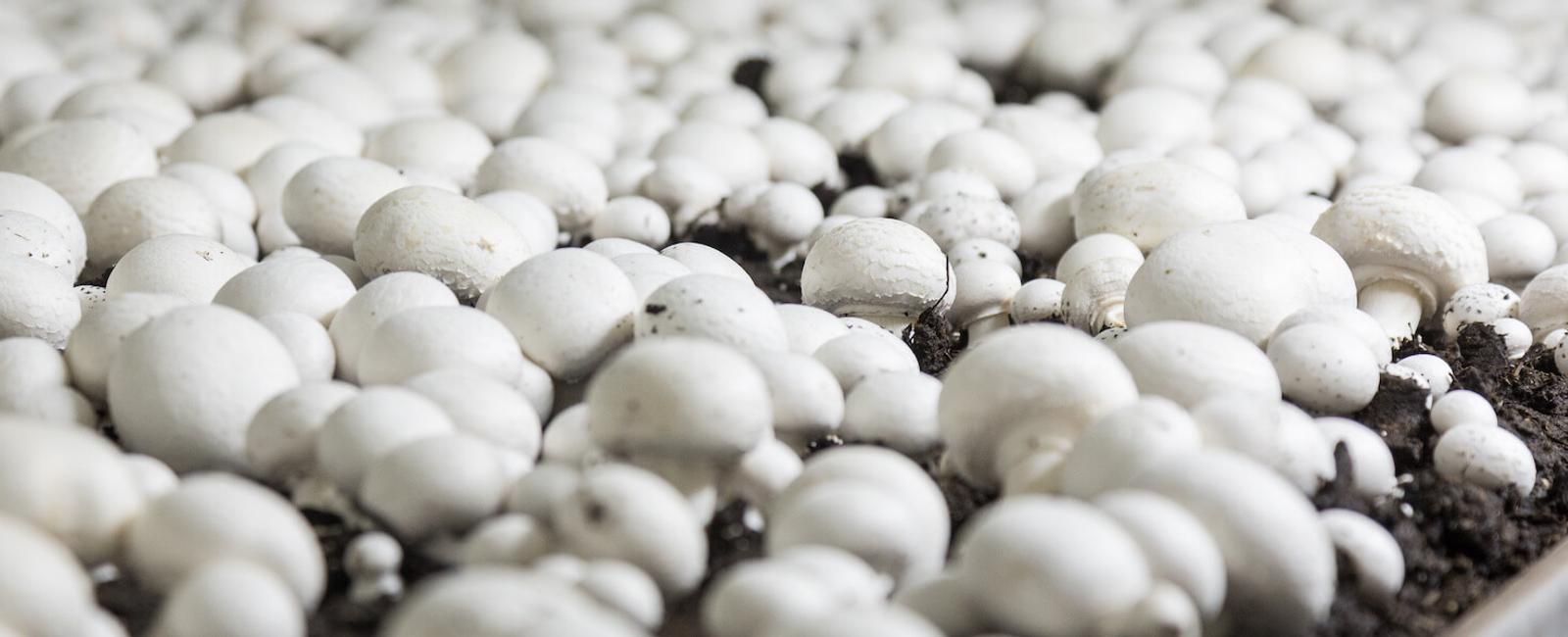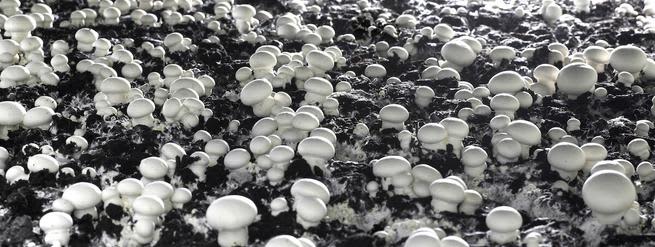

White mushrooms are a variety of Agaricus bisporus—the most common edible mushroom in the world. Known for their small size and versatility, white button mushrooms are ideal for anyone looking to implement fungi in their day-to-day diet.
Here, we’ll give you all you need to know about the white mushroom, including its varieties, taxonomical history, and possible habitats. We’ll also review some of its promising health benefits and fantastic nutritional values.
What are white mushrooms?
Also known as white button mushrooms, button mushrooms, and common mushrooms, white mushrooms are probably the most common form of the famous Agaricus bisporus. This edible fungus is the most popular mushroom species in the world, generating more than one billion dollars in revenue each year.
White mushrooms refer to a specific variety of A. bisporus, scientifically known as Agaricus bisporus var. albidus. While its nutritional values and health benefits are the same as other A. bisporus varieties (such as portobellos or cremini mushrooms), it differs in that it’s much smaller in size and white in color.
White button mushrooms are found all over the world. They slightly prefer tropical climates in the northern hemisphere, but it’s also possible to find them in other regions. Usually, they grow close to dung and manure, which makes them a common sight near stables and compost piles (1) (2).
These fungi and other A. bisporus varieties are known for their subtle umami flavor and earthy odor. Yet, white mushrooms are particularly popular due to their small size—making them ideal for using them as toppings or salad ingredients.
How do white mushrooms look?

White mushrooms are small but thick fungi. The usual Agaricus bisporus cap measures between 2.5–14 cm (1–5.5 in), with its color ranging from white to brown. The stem is rather short, measuring 2–7 cm (0.7–2.7 in) long. Naturally, you can expect white mushrooms to fall on the shorter side of these measurements.
The spore print of these fungi is usually dark brown—but remember that it’s hard to obtain it from store-bought white mushrooms. Another thing to remember is that A. bisporus’ stem will show red or brown spots when bruised (1) (2).
What are the varieties of white mushrooms?
As mentioned, white mushrooms are generally considered a variety of Agaricus bisporus. A variety (also called strain) is a mycology term akin to what we usually call race—a specific set of variations among a single species.
White mushrooms, in that sense, comprise the entire Agaricus bisporus var. albideus strain. There are at least five other strains of Agaricus bisporus, all of which are widely recognized among expert mycologists (3):
- Agaricus bisporus var. avellaneous
- Agaricus bisporus var. bisporus
- Agaricus bisporus var. burnettii
- Agaricus bisporus var. eurotetrasporus
- Agaricus bisporus var. pettubescens
However, not everyone agrees that white mushrooms are a variety. Instead, you’ll find that many online sites claim that white buttons are simply immature versions of A. bisporus. This fungus is known to turn brown with age, so young specimens will be small and almost entirely white.
We know this can be confusing—so we recommend you just keep in mind that button, cremini, and portobello mushrooms are all the same species. Yet, they are different in some aspects.
White mushrooms are smaller in size, white, and usually used in salads or as toppings. These are also called champignons or baby bellas. Similar to buttons are cremini mushrooms, which are slightly larger and have a distinct brown color.
The final variety is portabella or portobello mushrooms. These are larger specimens with a brown color and a firm texture. Most often served on their own, portobellos make for a fantastic main dish.
History of white mushrooms

The popularity of Agaricus bisporus doesn’t come out of nowhere—there’s a possibility that some ancient cultures ate these delicious fungi. Experts indicate that, for example, Ancient Egyptians considered fungi a delicacy given by the gods to the highest of nobles.
Button mushrooms grow in North Africa, so it’s not crazy to think that some privileged Egyptians had the chance to try out these fungi. Yet, these are all speculations—there aren’t any known records documenting this (4).
As for its official taxonomy, scientists first spotted Agaricus bisporus during the 1890s. The story tells that some North American mycologists became obsessed with a new, uncataloged species that grew in Massachusetts.
However, it wasn’t until 1900 that someone categorized it properly. Charles Horton Peck, a renowned mycologist, described it under the name Agaricus brunnescens—a synonym of what’s now known as A. bisporus.
In 1971, David Malloch took the research a step further by establishing the species’ key characteristics. He discovered and named several varieties, along with other synonyms such as Agaricus campestris (5).
Not much has changed since then. While some new varieties have been recognized, most researchers gloss over this mushroom due to its unprecedented popularity.
Health benefits of white mushrooms
White mushrooms are composed of more than 90% water—however, this doesn’t stop them from being one of the most nutritional fungi out there. They provide a unique balance of both micro and macro nutrients, making them the ideal addition to any diet.
Experts indicate that a 100-gram serving of A. bisporus contains 3 grams of total protein, 0.3 grams of total fat, and 3.2 of total carbohydrates. In addition, it provides several micronutrients, such as (6):
- Potassium
- Calcium
- Niacin
- Vitamin A
- Vitamin C
- Vitamin D
- Several B vitamins, including riboflavin
While the exact amount of each of these will vary between specimens, adding a few champignons to your eating plan can help you reach the recommended daily values.
But experts also point out that the benefits of A. bisporus don’t stop there—research has shown that this fungus can have several therapeutic properties.
For example, a 2013 study determined that A. bisporus could potentially be useful for treating tissue damage. This property comes from a compound known as “fucogalactan”—a polysaccharide with significant anti-sepsis, antinociceptive, and anti-inflammatory benefits (7).
Similarly, researchers used two proteins (ABL and Abmb) present in white mushrooms to impact the immune system. The two compounds have shown promise in stimulating and modulating immune function and slowing down cancer growth (8).
Experiments in mice also indicate that A. bisporus could reduce blood glucose and cholesterol levels. It might even help manage age-related brain function decline. However, more research is necessary to fully confirm this (9) (10).
Where do white mushrooms grow?

White mushrooms have the same growth conditions as any other Agaricus bisporus variety. They grow all over the world, with a slight preference for tropical climates in the northern hemisphere. Yet, there have also been reports of white button mushrooms growing in the southern hemisphere.
Agaricus bisporus fruits for half a year, from late spring to early autumn. It grows in what is known as “enriched spawns”—for example, manured soil or compost piles. As such, it’s common to find them in stables and grasslands where cattle feed (1) (2).
There’s surprisingly very little information about the specific growth conditions of this species. However, it’s considered one of the easiest mushrooms to cultivate—so if you’re interested in growing your own edible fungi, this might be a good place to start.
What is ethical wildcrafting?
Wildcrafting refers to harvesting natural resources for medicinal purposes—this differs from the concept of foraging as the latter describes harvesting for food. However, not many people know that there are a few guidelines to avoid any possible damage to the environment when harvesting.
This practice, known as “ethical wildcrafting,” is getting increasingly popular each year. Ethical harvesting is crucial to keep your local fungi populations thriving. Here are some basic rules of ethical wildcrafting:
- Do your homework before heading out. This includes learning about local species, and finding out which ones might be endangered.
- Carry a field guide. This will allow you to distinguish between similar-looking fungi and avoid accidentally harvesting the wrong ones.
- When you do find something you want to harvest, be respectful of the environment. Take only what you need, and do not disclose patch locations to other people.
- Finally, make sure to follow any applicable laws or regulations. This might involve getting permission from landowners or checking to see if harvesting is allowed on public land.
Is it safe to wildcraft for white mushrooms?
Unfortunately, it’s never 100% safe to eat wild-picked mushrooms. The risk of having picked a poisonous lookalike is always there. In the case of white mushrooms, this may include several white variations of Amanita species, which are known to be extremely toxic.
Plus, wild mushrooms often carry toxins from the environment, which could lead to indigestion and several other gastric problems. Make sure to only consume wild mushrooms under the close supervision of a professional.
How do you take white mushrooms?

Agaricus bisporus is widely recognized for its versatility. White mushrooms, in particular, go with almost every meal—either as a topping or side dish. For example, many people sprinkle chopped white mushrooms over pizza or pasta.
However, they can also be a main ingredient in soups, salads, and stews. Don’t be afraid to experiment. The internet has hundreds of white mushroom recipes that even beginner cooks can try out. As for cooking methods, it’s common to stir-fry them—but you can also boil, simmer, sautée, and roast them.
You can also try mixing it with any other mushroom variety you can think of. Shiitakes and pink oysters are typical examples of fungi that go well with white mushrooms.
Some people eat raw white mushrooms—but we reckon the taste and texture might be a bit overwhelming. If you still want to try uncooked fresh mushrooms, make sure only to use store-bought mushrooms.
White mushrooms: A timeless classic
White mushrooms are among the most common edible fungi, present in most kitchens worldwide. They’re incredibly versatile, and are a good starting point for amateur cooks who want to implement fungi into their recipes. Plus, they have several health benefits that might make them key to future cancer and wound treatments.
If you want to find out about other types of mushrooms, keep up on shroomer. Here, you’ll find all the details you need about psychedelic and functional fungi from all over the world, along with the latest news on medicinal research on edible mushrooms.
References
- Kuo, M. “Agaricus Bisporus.” (2018). https://www.mushroomexpert.com/agaricus_bisporus.html
- Paul Stamets, J.S. Chilton. “Agaricus brunnescens Peck.” in The Mushroom Cultivator (1983), 164–167.
- MycoBank. “Agaricus bisporus.” No date. https://www.mycobank.org/page/Name%20details%20page/708
- Adel F. Ahmed, Ghada Abd-Elmonsef Mahmoud, Mohamed Hefzy, Zhenhua Liu, and Changyang Ma. “Overview on the edible mushrooms in Egypt.” Journal of Future Foods 3 (2023): 8–15. https://doi.org/10.1016/j.jfutfo.2022.09.002
- David Malloch. “Agaricus brunnescens: The Cultivated Mushroom.” Mycologia, 68(4) (1976): 910–919. http://www.jstor.org/stable/3758807
- FoodData Central. “Mushrooms, white, raw.” April 2018. https://fdc.nal.usda.gov/fdc-app.html#/food-details/169251/nutrients
- Andrea C. Ruthes, Yanna D. Rattmann, Simone M. Malquevicz-Paiva, Elaine R. Carbonero, Marina M. Córdova, Cristiane H. Baggio, Adair R.S. Santos, Philip A.J. Gorin, Marcello Iacomini. “Agaricus bisporus fucogalactan: Structural characterization and pharmacological approaches.” Carbohydrate Polymers, 92(1) (2013): 184–191. https://doi.org/10.1016/j.carbpol.2012.08.071
- Wangsa Tirta Ismaya, Raymond Rubianto Tjandrawinata, and Heni Rachmawati. “Lectins from the Edible Mushroom Agaricus bisporus and Their Therapeutic Potentials.” Molecules, 25(10): 2368. https://doi.org/10.3390%2Fmolecules25102368
- Sang Chul Jeong, Yong Tae Jeong, Byung Keun Yang, Rezuanul Islam, Sundar Rao Koyyalamudi, Gerald Pang, Kai Yip Cho, Chi Hyun Song. “White button mushroom (Agaricus bisporus) lowers blood glucose and cholesterol levels in diabetic and hypercholesterolemic rats.” Nutrition Research, 30(1) (2010): 49–56. https://doi.org/10.1016/j.nutres.2009.12.003
- Nopporn Thangthaeng, Marshall G Miller, Stacey M Gomes, Barbara Shukitt-Hale. “Daily supplementation with mushroom (Agaricus bisporus) improves balance and working memory in aged rats.” Nutrition Research, 35(12) (2015): 1079–1084. https://www.sciencedirect.com/science/article/abs/pii/S0271531715002250?via%3Dihub


